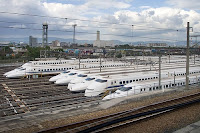 As a mode of transportation these superfast trains have many advantages. Transports a large power and most importantly with the same comfort, pollution generated can be one-tenth smaller than by plane. These trains are still using conventional wheels but with a sophisticated machine and the latest using superconducting magnetic technology Levitation (maglev train) that float above the rails.
As a mode of transportation these superfast trains have many advantages. Transports a large power and most importantly with the same comfort, pollution generated can be one-tenth smaller than by plane. These trains are still using conventional wheels but with a sophisticated machine and the latest using superconducting magnetic technology Levitation (maglev train) that float above the rails.Fast Train Jepang !
Tokaido Shinkansen - Japan
Japan shocked the world by launching a fast train Shinkansen (bullet train) in 1964 to serve the route Tokyo-Nagoya-Osaka-Kyoto, and speed "only" around 201 km / h (in the year already the fastest).
WIN 350 Eksperimental:
JR E3
JR E4
Each track has its own names (Tokaido, Tohoku, etc.), and each type of train is identified by a nickname (Nozomi, Hikari, etc.). Almost 40 years since it first launched, Shinkansen already carry 6 billion passengers without a significant accident. Shinkansen route also has a very high frequency, such as routes Tokyo and Shin-Osaka passable six trains a hour.
JR 300
"Hikari" means "light", is the first service on the route Shinkansen Tokaido / Sanyo. Since the emergence of Nozomi trains, currently provides a mid-level service with a few extra stops, but still with high speed. Hikari trains linking Tokyo and Osaka in approximately 3 hours. His appearance is more nuanced than the supersonic jet train, with a futuristic design and exceptional comfort.
Variations JR 500
Means "hope", Nozomi trains it only takes 2.5 hours to travel the Tokyo-Osaka, and 5 hours up to all destinations in the southernmost tip of the island in Hakata (Fukuoka). Train paths in this Japanese commercial support mobilization dense population in these areas, although to run it each train would cost up to $ 40 million.
JR 800 Series Latest
Special "Storm Troopers":
























